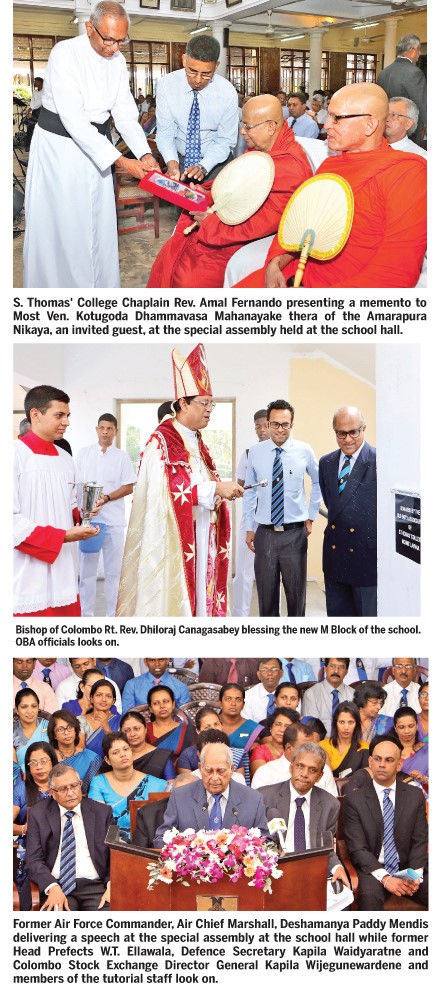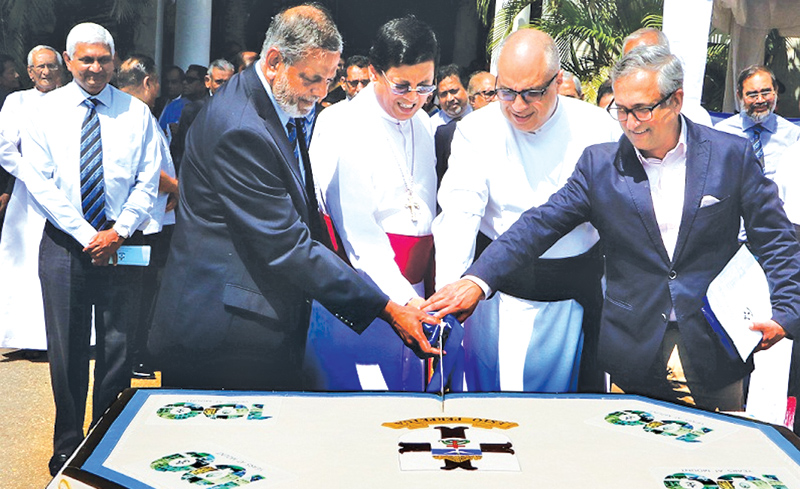100 years at Mount: St. Thomas’ College principal speaks 26th January 2018
STC celebrates 100 years at Mount Lavinia
by: Zahrah Imtiaz
Bishop of Colombo Rt. Rev. Dhiloraj Canagasabey joins Warden Rev’d Marc Billimoria and former Wardens Dr. David Ponniah and Prof. Indra de Zoysa in cutting the 100 year anniversary cake. Pictures by Saman Sri Wedage
The school by the sea; S. Thomas’ College yesterday celebrated 100 years since it started life in Mount Lavinia, having moved there from Mutwal on January 26, 1918.
The school celebrated this important milestone with a special mass held at the College chapel, the rededication of the two original buildings, a blessing of the newest building for the Lower School and a ceremonial general assembly with the participation of all the students in the school for the first time in its history.
The special mass was celebrated by Bishop of Colombo Rt. Revd. Dhiloraj Ranjit Canagasabey.
Keeping the Covenant
Speaking at the Mass held at the College Chapel, former Colombo Bishop Rt. Rev. Duleep De Chickera, who was S. Thomas’ chaplain and sub warden, highlighted the importance of a Thomian ‘Covenant’- so as to pass on the values of the school to generations to come.
“If there is no covenant written, we have to discern it, live it and pass it on,” said the Reverend.

“Over the last 100 years, everything had changed at the school but the one unchanging feature of the Thomian institution was its commitment to integrated education,” he said.
This, he said, was the schools’‘covenant to education’- not written but adhered to nevertheless.
“The covenant of course includes religion specifically that of Christianity but it also goes beyond that. The reason being that our family is an interfaith one. We are an equal interfaith family,” he said.
A boy of any religion can become head prefect of this school, “He can also be an agnostic in future and we have to accept that,” said Rev. De Chickera.
Overall, however, this one interfaith family is governed by Christian values. So the warden and majority of the board of governors have to be Christian, “This paradox has given birth to the Thomian Education Covenant,” he added.
The former Bishop also spoke of three important factors that need to be included in the Thomian education system.
One, he said, was that the child; full of integrity and creativity, should remain the centre of the institution.
He also stressed that it was important to not treat children as passive recipients, “This will kill his/her initiative and destroy our quality of life.”
Secondly he asked that the Thomian Covenant open a window into the outside world, “There is a bigger world out there, we must never lose sight of this.”
Warden Lyn Illangakoon, he said, started the culture of taking groups of boys across the railway to tend to the wounds of fishermen and thereafter across Galle road to teach children in low income families, “These boys since then have been crossing boundaries.”
The real world should be introduced to the classroom and this the challenge to our education system, said Rev. De Chickera.
Lastly, he spoke of the model of education S. Thomas’ had chosen to follow,
“We have government schools which are rigid, not independent, frightened of change and politicised. On the other hand, we have international schools which are profit-oriented and run to make someone money. But we in S. Thomas’ have chosen the middle path or the third option,” he said.
He explained that this thinking has also spilled into the university sector with educationists saying that they needed a third option between government and private universities. Thus, the government took on this proposal to introduce a fee levying, but government owned medical university which would be established in SLIIT, replacing SAITM.
“This model allows our schools to be independent to a certain extent, and though private not profit-oriented,” said Rev. De Chickera whilst he encouraged dialogue between government and international schools to incorporate the best of both worlds,
“To compete would be trivial and to be aloof, snobbish,” said the bishop.
Keeping the Thomian Covenant within the school will make it a great school, said the Reverend, but the difficult part was ensuring that the Thomians who leave the school gates, live by it and go out and make a better world.
It is through this that the illustrious men will pass on the rich quality of life to the next generation, he said.
After mass, the gathering moved on to the main hall where the special general assembly was held under the auspices of S. Thomas’ Warden, Rev. Marc Billimoria.
Weathering the storm
Tracing the history of the school, he noted that its founder Bishop Chapman first had his eye on the Governor’s House in Mt. Lavinia (now Mt. Lavinia Hotel) but later switched to Mutwal, a highly fashionable residential address at the time as he could not afford to purchase the Governor’s House.
For 67 years, it grew and prospered there, he said. Despite the early years of success, the school underwent a number of years of turmoil after Bishop Chapman.
“When Warden Miller took over in 1878, he found the school at the lowest steps of adversity in terms of both human and financial resources. And wardens after him, including myself had to launch many fund raising appeals to ensure that the school continued to function. With patience and courage, Warden Miller secured the future of the school. By the time he retired in 1891, the school was once more on a firm footing,” he said.
During the Miller years, the school also embarked on several significant steps; in 1880 the first Royal-Thomian cricket encounter was held. In 1884, the college colours of blue, black and blue were introduced and in 1886, the Old Boys’ Association, one of the oldest school alumni associations in the world, was established, to name a few.
But one problem Warden Miller could not address was the increasing student population and lack of space.
The establishment of coal sheds within a short distance from the school also meant that much of the coal dust enveloped the school as the Colombo Harbour expanded, explained the Warden.
By 1915, the school in Mutwal was sealed and the new property in Mt. Lavinia was purchased, ironically within walking distance from the first place considered by its founder.
During the December holidays of 1917, the school was moved to Mt. Lavinia.
It has flourished since then under 11 wardens and prospered through academic and sports achievements. It was also a time when the chapel and the Board of Governors were established.
The school has weathered many storms and a school which has survived and prospered for over a century is bound to have been a witness to history itself – especially that of our education struggles.
The incumbent Warden traced this history as;
“During the 26 years in which Warden de Seram held sway witnessed the disruption of World War II, the founding of the three branch schools, the achievement of the private fee levying status and the achievement of excellence in every sphere.
The 1960s had Warden Davidson and Selvaratnam as the school faced challenges of nationalism with fortitude and courage.
In the 1970s, under Wardens Anandanayagam and Illangakoon when the education system in Sri Lanka was in the throes of chaos, STC stood firm in the midst of the changing scenes.
In the 1980s, Warden Alwis not only built buildings but also brought about excellence in academic, sports and other fields.
In the first decades of the 20th century when Warden Ponniah and Puddefoot ran the school, radical changes took place in the field of education.
And during our contemporary times, Warden Indra brought international experience into the classroom.
“S. Thomas’ College has thrived and grown in Mt. Lavinia,”he said.
“Through it all, we attempted to be faithful to Bishop Chapman’s vision from every quarter to build men of character to take on the changing systems of the world and contribute to the nation and the world,” he said.
From four Prime Ministers in independent Sri Lanka to numerous public servants, members of the judiciary, clergy, defence personnel, diplomatic service and numerous other fields, S. Thomas’ has produced outstanding leaders and decent men who have added flavour to the social fabric of this and many other nations, added the Warden.
The event also had the school’s alumni address the assembly and this included; Air Chief Marshall Deshamanya P.H. Mendis (the first Thomian Air Force Commander), W.T. Ellawala (Head Prefect 1957-1958), J.D. Bandaranayake (Head Prefect 1966-1967), V.P.W. Wijegunawardena (Head Prefect 1989-1990), Defence Secretary K.M. Waidyaratne (Head Prefect 1978), Dr. N.G.R. Perera (Head Prefect 1992), D.S. Rajasingham (Head Prefect 2009-2010) and S.D.S. Sansoni (Head Prefect 2017-2018).
The event also had the unveiling of the portrait of Bishop E.A. Copleston by the Emeritus Archdaecon of Galle, Ven. V.L.P. Fernando and the unveiling of the bust of Warden W.A. Stone by Esmond Satarasinghe.
A special song written by Priya Peiris was sung by the Canto Perpetua Choir.









No Comments